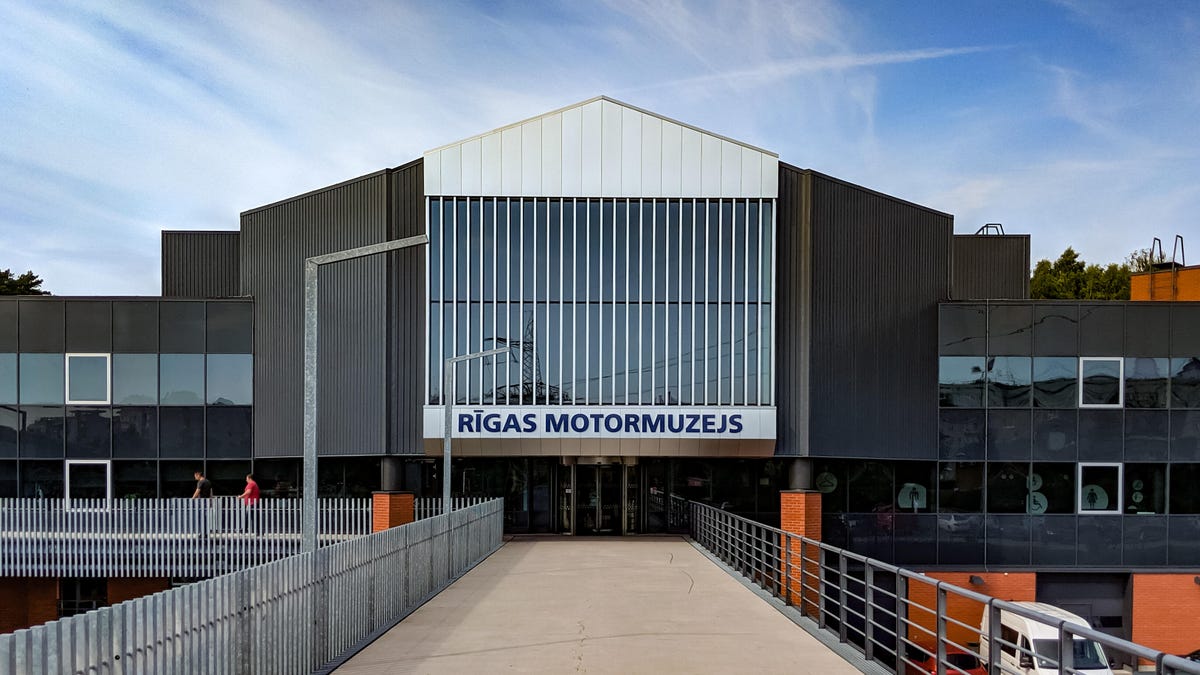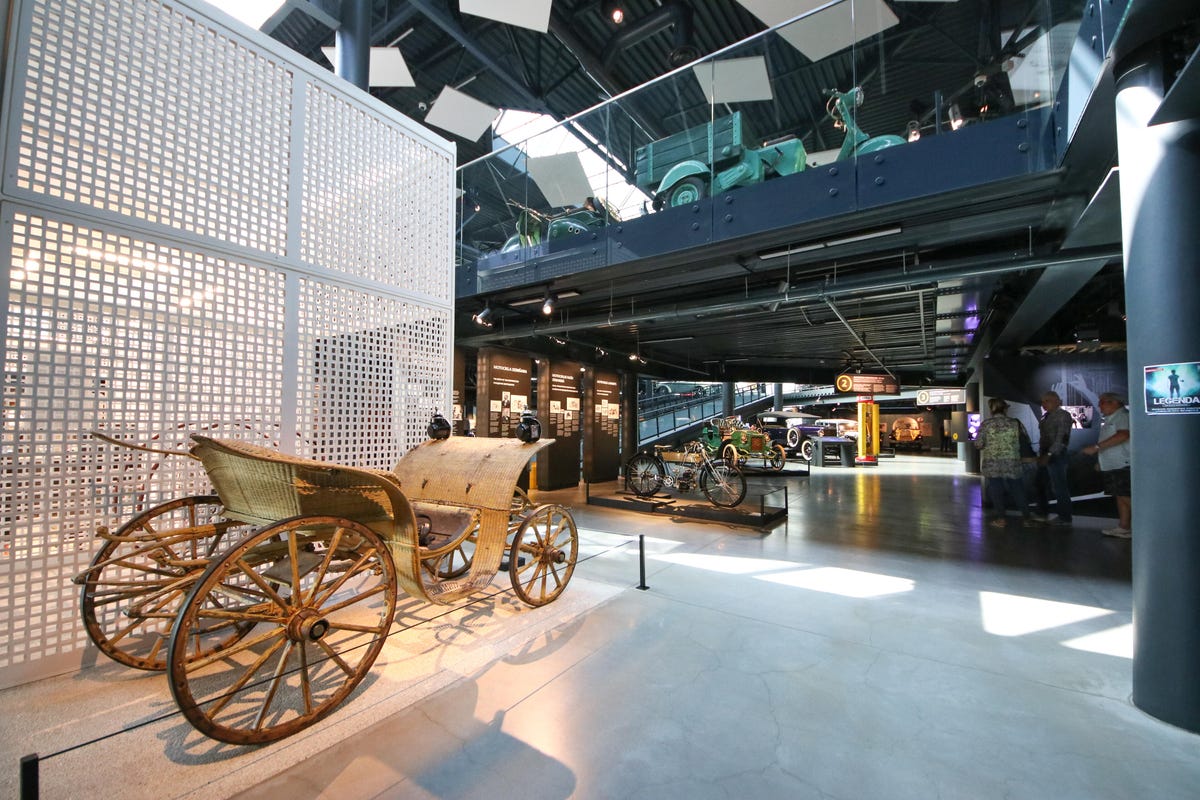Soviet and Baltic classics at the Riga Motor Museum
Check out the trucks and cars of the USSR at this excellent museum in Latvia.

Riga Motor Museum
How can you not love a car museum that looks like a car? This is the entrance to the Riga Motor Museum.

Travelling through time
The main floor of the museum is laid out in a largely chronological fashion, with the oldest right as you enter.
First Latvian car
The Krastin Automobile Company was founded 2 years before Ford, in 1901. It was the brainchild of Latvian-born engineer and inventor Augusts Krastiņš. The Cleveland, Ohio factory burned down in 1904, and the company folded shortly after. This is the only known survivor of the 10 or so that were built.
Her name is REO
A 1905, 7.5-horsepower, one-cylinder REO Model B Runabout. REO was founded by Ransom Olds who also started Oldsmobile.
Purple Selve
A Selve 12/50 from 1928. The company would only last one more year before it folded during the Great Depression.
Baby Bimmer
This a 3/15 DA-4, the fourth version of BMW's first car. It's based on the contemporary Austin Seven.
European classics
In addition to Fords, Chevys and Buicks, there are also European antiques from the early days of the automobile. On the left, a Renault 10 CV (aka the Type KZ). On the right, a Fiat 503.
Fiat
The 503 was based on the earlier 501, Fiat's first post-WWI car. It had a 1.5-liter inline-4 that produced 27 hp.
French mid-size sedan
The KZ had a 35-hp, 2.1-liter, inline-4 engine and a three-speed manual transmission.
Riga bus
The RAF-976 was in production from 1959 to 1991. It was based on the GAZ-51 truck chassis. The body is made of wood, tin, cardboard and plywood which, as you can probably guess, didn't last too long in Northeast Europe.
Grimacing van
A Latvian-built RAF-997E which were produced between 1958 and 1976.
Fenders for days
This unique vehicle is a REAF-50. It was a prototype using local and other Soviet parts. It never made it past the prototype stage as Moscow rejected it due to poor performance, poor fuel economy and difficult maintenance.
Eastern van
This is an RAF-2907, a van based on the RAF-2203 Latvijas. These vans were built in Latvia and used throughout the Soviet Union. You can see several in the HBO series Chernobyl since they were a common sight in the 1980s.
Concept
This is a RAF-M2 concept vehicle, an update for the 2203. RAF went out of business before production could start.
All aboard
This PAZ-672, which were built from 1967 to 1989, has a video playing in front of the windshield that shows a typical bus route through rural Latvia.
Coat of many colors
This 2203 is white, but thanks to multiple projectors shining on it, and a nearby console, you can "paint" it lots of normal and fantastical colors and designs.
Latvian Fords
The Ford-Vairogs company built Ford-licensed vehicles in Riga in the late 30s before it was taken over by the Soviet government. This is the Junior de Luxe, based on the British Ford Prefect. This example was one of the first vehicles restored and displayed at the museum.
German fire engines
On the left, a Henschel Type 33 D1, in fire engine guise. On the right, a Magirus ladder truck, from the company who invented them.
Porsche powered (technically)
The Wanderer W240 was powered by a 2-liter inline-6 developed by Ferdinand Porsche. The company would later become part of Auto Union and eventually Audi.
FWD
Two early front-wheel-drive vehicles. On the right is a DKW F8. All F8s had two-cylinder, two-stroke engines. The 0.6-liter version in this car produced 18 hp. On the left is an Audi Front, the first European car to have a 6-cylinder engine driving the front wheels.
Blue and black BMW
The elegant 327/28, which featured a more powerful 79-hp inline-6 than the standard 327. Essentially a proto-M.
Upstairs
On the top floor is a mix of Soviet and, as seen here, decidedly not Soviet vehicles. On the right is a Simca 5, which is essentially a French-built Fiat 500 Topolino. Next to that, a Steyr Puch 500D, an Austrian-built Fiat 500.
Early Saab
This 1969 Saab 96 has a V4 engine, which is rare, and a freewheel clutch design, which is rarer still. That meant that no engine braking was possible, like when going down a hill. This was a carry-over from when it had a 2-stroke engine and such a device was necessary so the engine wouldn't run out of oil.
First VAZ
The VAZ-2101 was the first car built by the AvtoVAZ company, and was a modified Fiat 124. It was exported as a Lada.
East German
This is a Trabant P50, designed and built in East Germany. It has a duroplast body over a steel chassis.
Take what you can get
It was, by all accounts, a terrible car. However, the waiting list to get one was only 10 to 13 years.
Fast Czech
Fast and streamlined for its day, the Tatra 87 had a top speed of 99 mph (160 km/h) with only 85 hp.
Fins
The 3.0-liter V8 was mounted in the back, under the single rear fin. This example was restored at the museum.
Need for speed
Some high speed experimental/research vehicles. That's an ARVW on the right, which was the fastest diesel car in the world in 1980. Behind is the Pioneer 2M, a turbine-powered Soviet land speed record car from the 60s. On the left, with bullet-shaped sidecar, is the Latvian-built EKE-1 that held several Soviet speed records in the '50s.
Cobra-like
One of only 2 ZIL-112 Sports built, it shared many parts with some of its '60s Soviet contemporaries, like the ZIS-110 and GAZ Volga sedans (both of which you'll see in a moment). This example was powered by a modified 6.0-liter V8 that developed 230 hp.
Latvian racer
The OSCar 01 raced and finished the 2004 Dakar Rally. It was designed and built in Latvia, and used a mix of fabricated and off-the-shelf parts. The windshield, for example, is from a Ford Focus. The engine is a 4-liter, 286-hp BMW V8.
Restored racer
This is a French Amilcar CGS, once owned by a Latvian race driver. With it he raced in the 1935 Monte Carlo Rally. It was found in a barn in Poland in the 70s and restored. The 1.1-liter inline-4 generated 30 hp.
The Kremlin Collection
In a rather glaring example of "some are more equal than others," Soviet leaders were chauffeured around in massive land yachts. The museum has several examples.
Armored cruiser
This is a ZIS-155, an armored version of the 110. In the long nose is a 6-liter inline-8 that drives the rear wheels via a three-speed manual transmission. A creepy Stalin sits in the back of what was once one of his actual limos.
Not a Packard or a Chevy
If this looks like a knock-off '50s American sedan, you're not wrong. The GAZ-13 was in production from 1959 to 1981 and featured a 195 horsepower V8 that had to lug around a 4,630 pound (2,100 kg) vehicle.
A rental for the people
Ordinary citizens couldn't buy GAZ-13s, but they could rent one for weddings. Some were built in Riga, including a station wagon and an ambulance variant.
Heavyweight
The mid-60s Politburo-only ZIL-111G offered features not found in mainstream Soviet vehicles of the era, like power windows, air conditioning, and an automatic transmission. It weighed a massive 6,206 pounds and was powered by a 200-hp, 6.0-liter V8.
Brezhnev's Rolls-Royce
Soviet General Secretary Leonid Brezhnev was a bit of a car collector, though perhaps not as much of a driver. He crashed this 1966 Rolls-Royce Silver Shadow in 1980.
Oh my
He seems rather surprised about the truck that appeared in front of him.
Emka
A GAZ-M1 Emka from the late '30s and early '40s. Over 60,000 were produced, making it a very popular vehicle of the era in the Soviet Union. Behind is a GAZ-12 ZIM, one of the few higher-end vehicles sold to regular citizens.
Convertible limo
This ZIS-110B, ostensibly a reverse-engineered Packard from the era, had an interesting exhibit. You could get yourself photographed at a nearby stand, and the video in the background would show you in the car on parade.
Riga local
This example was used for parade duty in the '50s by the Baltic Military District commander stationed in Riga.
For the people
The GAZ-M20 was a popular post-war sedan and convertible. This example features the 52-hp, 2.1-liter inline-4. Behind is a GAZ Volga, which replaced the M20 and was made, with many updates, until 2010.
Heads-up display
This Volga features a sort of head-up display: a standard speedometer with a glass back to made it easier to see.
Moskvitch
The Moskvitch 408 was a successful sedan, station wagon, and van, built from the mid-'60s to the mid-'70s. It sold well within the Soviet Union, and rare for the cars we've seen here, was also widely exported throughout Europe.
For the kids
A rather clever integrated kids seat.
Micro mini
The SMZ S3A M was a specially built microcar for disabled drivers, given to them for free, or at a steep discount.
Special layout
Note the special control layout. It was powered by a 10-hp, 0.35-liter single-cylinder two-stroke engine.
A gathering of the people
From left to right: a ZAZ 965, ZAZ 966V, Moskvitch 401/420, and a Moskvitch 401/422 woodie. Combined, these vehicles have 109 horsepower.
Latvian loveliness
The Riga Motor Museum is full of vehicles you rarely see in the US or the rest of Europe. It's definitely worth a visit, if you find yourself up that way. It's open most days from 10-6.

